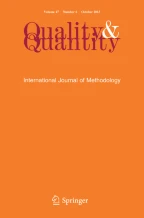Summary
The two examples included in this section illustrate different facets of the analysis of data by means of log-linear models. The first example illustrated the classic analysis by means of unsaturated models for which there are now dozens of examples in the literature. However, as was shown by studying the sources of lack-of-fit — in other words by looking at the residuals — it was possible to identify a “rogue” cell and then to find a much simpler model. The second example explored an avenue of research which is, at present, little documented. The diagonal-crossings model presented in the previous sub-section is in fact the basis of the analysis of Swedish voting data by Upton and Särlvik (1979) where it has been found to provide new insights into the nature of voting changes. One may expect that model-building of this type will become increasingly common.
Perhaps the essential message to be learnt from the two examples is that every data set presents its own problems, and that data cannot simply be analyzed by feeding it into a computer program. The log-linear model is not the end of data analysis for contingency tables but the starting point.
Similar content being viewed by others
References
Aitkin, M. (1978). ‘The analysis of unbalanced cross-classifications’,J. Roy. Stat. Soc. A. 141: 195–223.
Anscombe, F.J. (1953). Contribution to discussion of paper by Hotelling, H. ‘New light on the correlation coefficient and its transform’,J. Roy. Stat. Soc. B. 15: 229–230.
Armitage, P. (1966). ‘The chi-square test for heterogeneity of proportions after adjustment for stratification’,J. Roy. Stat. Soc. B. 28: 150–163.
Bishop, Y.M.M., Fienberg, S.E. and Holland, P.W. (1975),Discrete Multivariate Analysis: Theory and Practice. Cambridge, Mass.: M.I.T. Press.
Blumen, I., Kogan, M. and McCarthy, P.J. (1955).The Industrial Mobility of Labor as a Probability Process. Ithaca, N.Y.: Cornell University Press.
Bock, R.D. (1975).Multivariate Statistical Methods in Behavioral Research. New York: McGraw-Hill.
Brown, M.B. (1976). ‘Screening effects in multidimensional contingency tables’,Appl. Stat. 25: 37–46.
Caussinus, H. (1965). ‘Contribution a l'analyse statistique des tableaux de correlation’,Ann. Fac. Sci. Univ. Toulouse 29: 77–182.
Dempster, A.P., Laird, N.M. and Rubin, D.B. (1977). ‘Maximum likelihood with incomplete data via the EM algorithm’ (with discussion)J. Roy. Stat. Soc. B. 39: 1–38.
Duncan, O.D. (1975). ‘Partitioning polytomous variables in multiway contingency analysis’,Soc. Sci. Res. 4: 167–182.
Everitt, B.S. (1977).The Analysis of Contingency Tables. London: Chapman and Hall.
Fienberg, S.E. (1972). ‘The analysis of incomplete multiway contingency tables’,Biometrics 28: 177–202.
Fienberg, S.E. (1977).The Analysis of Cross-classified Categorical Data. Cambridge, Mass;: M.I.T. Press.
Goodman, L.A. (1968). ‘The analysis of cross-classified data: independence, quasi-independence, and interactions in contingency tables with or without missing values’,J. Amer. Stat. Assoc. 63: 1091–1131.
Goodman, L.A. (1970). ‘The multivariate analysis of qualitative data’,J. Amer. Stat. Assoc. 65: 226–256.
Goodman, L.A. (1971). ‘The analysis of multidimensional contingency tables: stepwise procedures and direct estimation methods for building models for multiple classifications’,Technometrics 13: 33–61.
Goodman, L.A. (1972a). ‘A general model for the analysis of surveys’,Amer. J. Soc. 77: 1035–1086.
Goodman, L.A. (1972b). ‘A modified multiple regression approach to the analysis of dichotomous variables’,Amer. Soc. Rev. 37: 28–46.
Goodman, L.A. (1972c). ‘Some multiplicative models for the analysis of cross-classified data’, inProceedings of the Sixth Berkeley Symposium on Mathematical Statistics and Probability. Berkeley: Univ. of California Press.
Goodman, L.A. (1973a). ‘The analysis of multidimensional contingency tables when some variables are posterior to others: A modified path analysis approach’,Biometrics 59: 579–596.
Goodman, L.A. (1973b). ‘Causal analysis of data from panel studies and other kinds of surveys’,Amer. J. Soc. 78: 1135–1191.
Goodman, L.A. (1974a). ‘The analysis of systems of qualitative variables when some of the variables are unobservable. Part I — a modified latent structure approach’,Amer. J. Soc. 79: 1179–1259.
Goodman, L.A. (1974b). ‘Exploratory latent structure analysis using both identifiable and unidentifiable models’,Biometrika 61: 215–231.
Goodman, L.A. (1975). ‘The relation between modified and usual multiple regression approaches to the analysis of dichotomous variables’, pp. 83–110 in D. Heise (ed.)Sociological Methodology 1976. San Francisco: Jossey-Bass.
Goodman, L.A. and Kruskal, E.H. (1954). ‘Measures of association for cross-classifications I’,J. Amer. Statis. Assoc. 49: 732–764.
Haberman, S.J. (1974).The Analysis of Frequency Data. Chicago, Ill.: Univ. of Chicago Press.
Hauser, R.M. (1978). ‘A structural model of the mobility table’,Social Forces 56: 919–953.
Jennings, M.K. and Niemi, R.G. (1978). ‘The persistence of political orientations: an overtime analysis of two generations’,Brit. J. Pol. Sci. 8: 333–363.
McKinlay, J.B. (1973). ‘Social networks, lay consultation and help-seeking behaviour’,Social Forces 51: 275–291.
Morgan, B.J.T. and Titterington, D.M. (1977). ‘A comparison of iterative methods for obtaining maximum likelihood estimates in contingency tables with a missing diagonal’,Biometrika 64: 265–270.
Mosteller, F. (1968). ‘Association and estimation in contingency tables’,J. Amer. Statist. Assoc. 63: 1–28.
Nelder, J.A. (1974). ‘Log-linear models for contingency tables: a generalisation of classical least squares’,Appl. Stat. 23: 323–329.
Plackett, R.L. (1974).The Analysis of Categorical Data. London: Griffin.
Reynolds, H.T. (1977).The Analysis of Cross-classification. New York: Collier-Macmillan.
Reynolds, H.T. (1978). ‘Some comments on the causal analysis of surveys with log-linear models’,Amer. J. Soc. 83: 127–143.
Simpson, E.H. (1951). ‘The interpretation of interaction in contingency tables’,J. Roy. Stat. Soc. B. 13: 238–241.
Upton, G.J.G. (1977). ‘A memory model for voting transitions in British elections’,J. Roy. Stat. Soc. A, 140: 86–94.
Upton, G.J.G. (1978a). ‘Factors and responses in multidimensional contingency tables’,The Statistician. 27: 43–48.
Upton, G.J.G. (1978b).The Analysis of Cross-tabulated Data. Chichester: Wiley.
Upton, G.J.G. and Särlvik, B.H. (1979). A loyalty-distance model for voting change. In preparation.
Author information
Authors and Affiliations
Rights and permissions
About this article
Cite this article
Upton, G. Contingency table analysis: Log-linear models. Qual Quant 14, 155–180 (1980). https://doi.org/10.1007/BF00154797
Issue Date:
DOI: https://doi.org/10.1007/BF00154797
